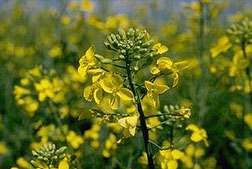This page has been archived and is being provided for reference purposes only. The page is no longer being updated, and therefore, links on the page may be invalid.
| Read the magazine story to find out more. |
|
|
Advancing Biocrop Alternatives in the Pacific Northwest
By Ann PerryFebruary 3, 2011
Pacific Northwest farmers could someday be filling up their machinery's tanks with fuels produced from their own fields, according to ongoing research by U.S. Department of Agriculture (USDA) scientists.
Since 2003, Agricultural Research Service (ARS) microbiologist Hal Collins and agronomist Rick Boydston have been studying safflower, camelina, soybeans, mustard, canola, wheat, corn and switchgrass to assess their potential for bioenergy production. ARS is USDA's chief intramural scientific research agency, and this research supports the USDA priority of developing new sources of bioenergy.
Collins and Boydston both work at the ARS Vegetable and Forage Crops Research Laboratory in Prosser, Wash., where they've found that the oilseed crops in their studies could someday help supply Washington State with renewable fuels. For instance, they've found that canola, which is already established as a summer crop in the Pacific Northwest, can also be grown in the winter both as a cover crop and potentially as a biofeedstock crop, because its seeds are around 40 percent oil.
Their results also suggest that it could take anywhere from 50 to 70 acres for a farmer with 1,000 acres and an onsite crusher and biodiesel facility to grow enough canola to produce the fuel needed to run on-farm operations.
The team also found that in field trials, camelina plants produced an average of 2,000 pounds of seeds per acre in 80 days, which translates into 700 pounds of oil—and eventually 93 gallons of oil—per acre. Safflower plants, meanwhile, produced around 3,000 to 3,500 pounds of seeds per acre, and white mustard seed meal could also be used as an organic fertilizer after the seeds were crushed to extract the oil for fuel.
Collins and Boydston also evaluated eleven switchgrass cultivars in their studies and found "Kanlow" to be the most promising cultivar for maximum production under sustainable irrigation strategies in the Pacific Northwest's Columbia Basin. Four years after the team planted the first crop, they measured yields of 14 dry tons per acre, which could translate into around 1,000 gallons of cellulosic ethanol per acre.
Read more about this research in the February 2011 issue of Agricultural Research magazine.

